#Regional sarees
Explore tagged Tumblr posts
Text
Sridevi Vijaykumar: Turquoise Dream in Samyakk Organza
Introduction
In the realm of haute couture, certain creations possess the uncanny ability to transcend mere fashion, evolving into exquisite works of art that capture the essence of beauty, grace, and sophistication. Recently, the spotlight shone brightly on the resplendent @SrideviVijaykumar as she graced the scene adorned in the enchanting Turquoise Blue Sequins Embroidered Organza Saree crafted by the esteemed artisans at Samyakk.com. Let's embark on a journey to unravel the m yriad intricacies that rendered this ensemble nothing short of sublime, and why Sridevi Vijaykumar emerged as the epitome of elegance and poise.
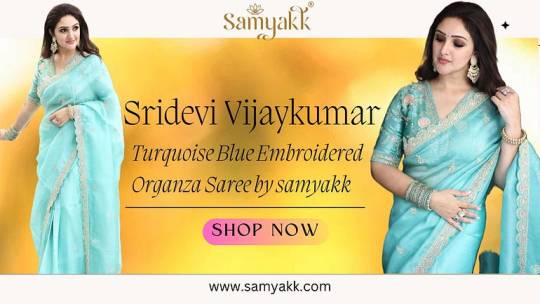
Organza: The Epitome of Sheer Elegance:
At the heart of Sridevi Vijaykumar’s mesmerizing ensemble lies the timeless allure of organza — a fabric renowned for its delicate translucence and ethereal drape. Woven from fine silk yarns, organza embodies a sense of understated luxury, its sheer texture lending a subtle yet enchanting quality to any garment it graces. As Sridevi Vijaykumar donned the Turquoise Blue Organza Saree, she effortlessly epitomized the essence of sheer elegance, exuding a timeless beauty that is both captivating and unforgettable.
A Symphony of Color:
Sridevi Vijaykumar looks absolutely enchanting draped in her Turquoise Blue organza saree, showcasing a quintessential Sridevi saree look. The serene hue reminiscent of azure skies and tranquil waters exudes calm sophistication, perfectly complementing her elegance. This choice not only accentuates her beauty but also reflects her refined taste and timeless style. With her impeccable saree ensemble, Sridevi epitomizes grace and sets a high standard for discerning fashion connoisseurs, creating an iconic Sridevi saree moment.
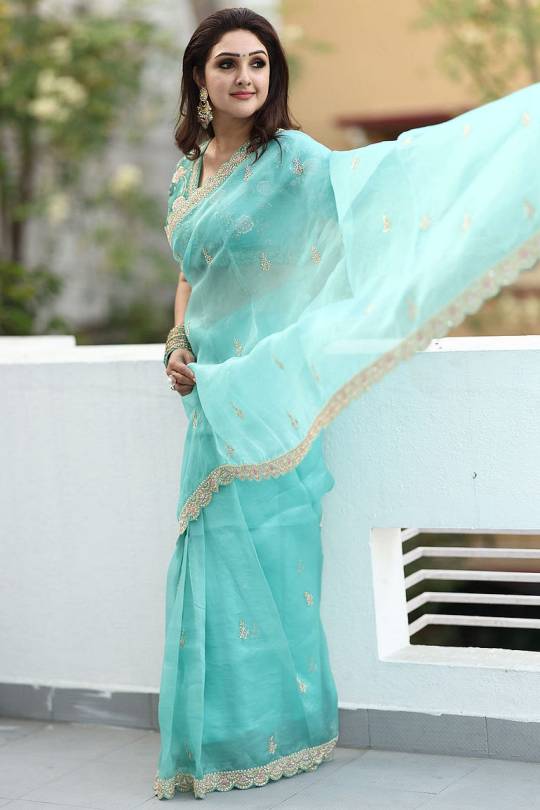
Masterful Artistry in Embellishments:
In the realm of elegance, the Sridevi Vijaykumar saree stands out with its turquoise grandeur. The unparalleled craftsmanship manifested in its intricate embellishments. Delicately woven Sequins, Cutdana, and Zardosi work adorn the fabric, bestowing upon it an ethereal quality that is simply mesmerizing. Each meticulously placed embellishment serves as a testament to the artisan’s skill and dedication, resulting in a symphony of textures and patterns that dance in harmony with every movement, creating an enchanting visual spectacle.
Exquisite Border and Pallu Embellishments:
The border and pallu of the saree stand as veritable masterpieces in their own right, showcasing a symphony of craftsmanship that is both opulent and refined. Embellished with Pearl, Cutdana, Zardosi, Resham, and Sequins work, the gold-colored border exudes an aura of regal splendor, adding a touch of grandeur to the ensemble. This ornate detailing not only enhances the visual appeal of the saree but also elevates it to a realm of unparalleled sophistication and luxury.
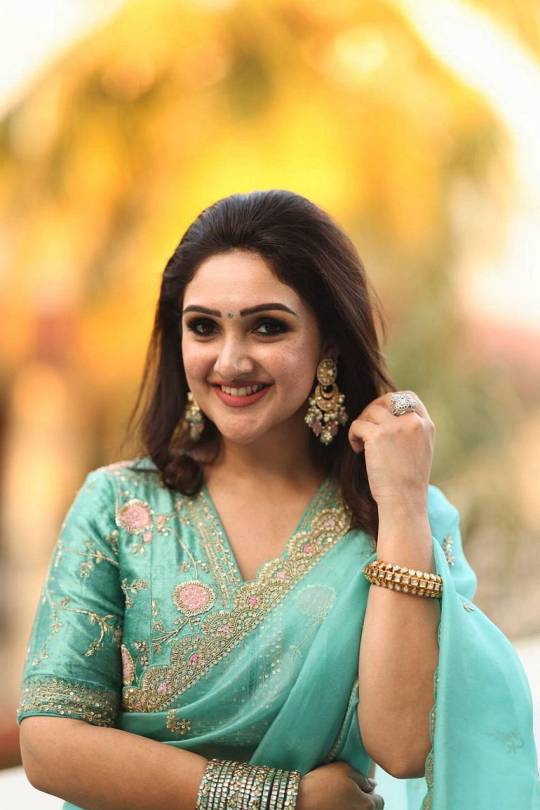
The Velvet Blouse: A Study in Elegance:
Complementing the resplendent saree is a Velvet Blouse in the same captivating Turquoise Blue hue. Crafted with meticulous attention to detail, the blouse features intricate Cutdana, Zardosi, Resham, and Sequins work that mirrors the embellishments found on the saree. The luxurious velvet fabric adds a sumptuous texture to the ensemble, creating a seamless fusion of elegance and opulence that is truly captivating.
Elegance Personified:
Sridevi Vijaykumar’s appearance in this stunning ensemble left an indelible impression, showcasing the quintessential Sridevi looks in a saree. Each graceful gesture breathed life into the fabric, weaving an enchanting narrative of elegance and sophistication. With her innate charm and impeccable style, Sridevi Vijaykumar elevated the saree to new heights, underscoring the essence of true beauty — wherein one’s demeanor and grace transcend mere attire. In this defining moment, she epitomized timeless elegance, redefining conventional notions and leaving a lasting legacy in the realm of fashion.
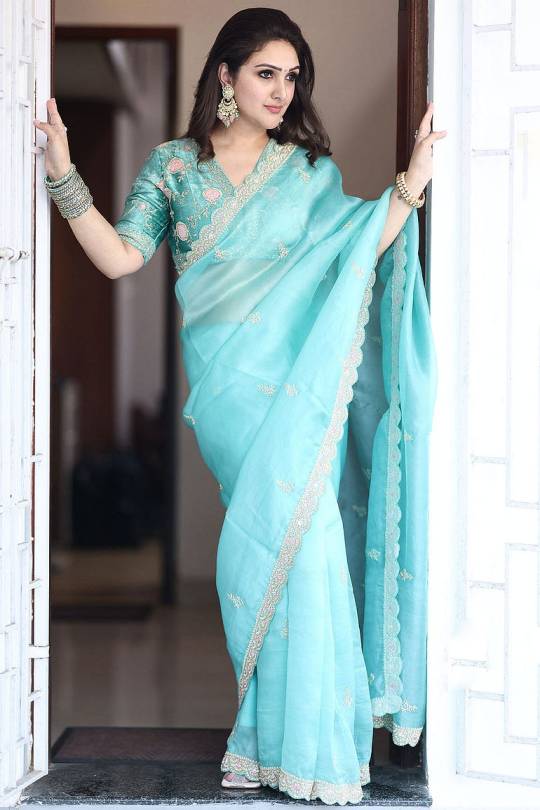
FAQs (Frequently Asked Questions)
What makes the Turquoise Blue Sequins Embroidered Organza Saree from Samyakk unique? A: This saree stands out for its impeccable craftsmanship, captivating color palette, and timeless allure. It epitomizes the brand’s commitment to excellence and serves as a testament to the enduring power of sartorial artistry.
What fabric is used in the creation of the saree? A:The saree is crafted from organza, a delicate fabric woven from fine silk yarns. Known for its sheer translucence and ethereal drape, organza lends a sense of understated luxury to the ensemble.
Can you describe the embellishments on the saree? A: The saree features intricately woven Sequins, Cutdana, and Zardosi work, which bestow upon it an ethereal quality that is simply mesmerizing. Additionally, the border and pallu are adorned with Pearl, Cutdana, Zardosi, Resham, and Sequins work, adding a touch of opulence to the ensemble.
How does Sridevi Vijaykumar’s choice of the saree reflect her style? A: Sridevi Vijaykumar’s choice epitomizes elegance and grace, showcasing a quintessential Sridevi saree look. With her innate charm and impeccable style, she elevates the saree to new heights, underscoring the essence of true beauty.
Does Samyakk offer other varieties of sarees? A: Yes, Samyakk has a wide variety of sarees in enticing hues, embroidery, and fabrics. From traditional Kanchipuram silk sarees to modern organza designer sarees and intricately embroidered pieces, their collection caters to every taste and occasion.
Does Samyakk offer international shipping? A: Yes, Samyakk provides international shipping services to customers worldwide. Whether you’re located in North America, Europe, Asia, Australia, or any other part of the globe, you can enjoy the convenience of having your desired saree or other garments delivered to your doorstep. Samyakk ensures a seamless shipping process, allowing customers from around the world to access their exquisite collection of sarees and other ethnic wear.
Conclusion: A Timeless Masterpiece:
In the rich tapestry of fashion, Samyakk.com shines as a bastion of diversity, offering a plethora of sarees in enticing hues, exquisite embroidery, and luxurious fabrics. From the traditional opulence of Kanchipuram silk sarees to the regal charm of Banarasi sarees, Samyakk’s collection spans the spectrum of timeless elegance. Moreover, their modern offerings, including organza designer sarees and intricately embroidery sarees, redefine contemporary fashion with flair. Sridevi Vijaykumar’s choice of the Turquoise Blue Sequins Embroidered Organza Saree from Samyakk epitomizes the brand’s commitment to excellence. With its impeccable craftsmanship, captivating color palette, and enduring allure, this ensemble stands as a testament to the enduring power of sartorial artistry. As Sridevi Vijaykumar graced the scene in this resplendent saree, she not only epitomized elegance and grace but also left an indelible mark on the annals of fashion history, serving as an eternal source of inspiration for generations to come.
Also Check Out:
Sakshi Agarwal Looks In Saree
Athulya Ravi Looks in Saree
Riya Suman in Saree
Kavya Gowda in Saree
#Embroidered sarees#Silk sarees#Wedding sarees#Bollywood sarees#Traditional sarees#Handwoven sarees#Party wear sarees#Georgette sarees#Printed sarees#Kanjeevaram sarees#Banarasi sarees#Chiffon sarees#Designer blouse sarees#Net sarees#Half sarees#Tussar sarees#Linen sarees#Sequin sarees#Contemporary sarees#Regional sarees#Designer sarees for wedding reception#Latest designer sarees collection#Designer sarees with blouse#Embellished designer sarees#Printed designer sarees online#Designer sarees for festivals#Designer sarees with price#Exclusive designer sarees#Custom designer sarees#Designer sarees for special occasions
0 notes
Text
Discover 26 Stunning Saree Styles from Across India
India's rich heritage and diverse culture are beautifully reflected in its iconic saree styles. At ShopFashionly, we’ve compiled an exciting blog to guide you through 26 stunning saree styles from across India, celebrating the craftsmanship and traditions behind each masterpiece.

From the luxurious Banarasi silk of Uttar Pradesh to the vibrant Bandhani of Gujarat and the elegant Kanjeevaram silk of Tamil Nadu, every saree tells a unique story. These exquisite drapes not only represent the cultural essence of their region but also make a statement of timeless elegance and grace.
Our blog dives into:
Classic and Regional Saree Styles like Chanderi, Patola, and Kasavu
Styling Tips for various occasions – be it weddings, festivals, or formal events
Draping Techniques to make your saree look modern yet traditional
Fun Facts about the history and significance of these sarees
Why You’ll Love This Blog:
If you’re a saree enthusiast or someone exploring Indian ethnic wear for the first time, this blog is your ultimate guide. Whether you're looking for an opulent ensemble for a wedding or a breezy drape for a casual outing, our guide has something for everyone.
Explore this treasure trove of saree styles and get inspired to add a touch of India's heritage to your wardrobe.
Read the Full Blog Here: Explore 26 Stunning Saree Styles from Across India
Let us know your favorite saree style in the comments and how you’d love to style it!
0 notes
Note
Hi could please write one where the reader is bengali and celebrates Durga Puja with Lando in india ( ollie or kimi works too but I'm not sure if you write for them)?
I did a ‘spin the wheel’ and got Ollie.
Puja Vibes
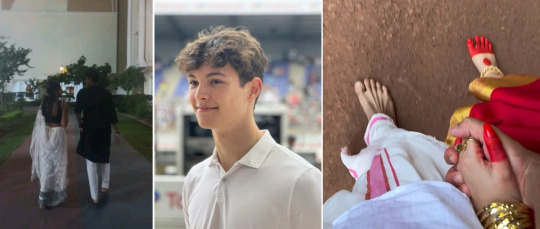
Ollie was as white as white gets and his girlfriend was the embodiment of the Bengali culture prancing around. She had helped Oliver expand his horizon; taught him new experiences and delicious food. She will argue, that there’s no dessert like Bengali dessert.
So, when it was time for Y/N to return home for Durga Puja, Ollie would be joining her too since he had no races or prior commitments.
They hadn’t dated for long but Ollie had showered her with gifts on Christmas and taught her all his family traditions. Y/N just wanted to do the same for him.
At the airport, they landed together with Ollie in tow who was enamoured by the hustle and bustle of the city. He saw cows crossing the road like it was another Tuesday and no one batted an eye. Y/N pointed out all the building explaining the significance and the reason behind their construction during the colonial era on the way to her home.
At home, preparations for Durga Puja were in full swing. Y/N’s uncle and aunt had decorated their house ornately. Oliver greeted everyone.
The festivities would start the next day. Everyone was up bright and early for the invocation (bodhon) Oliver was mesmerised by the shining lights and the bright colours and the beautiful way Goddess Durga was dressed.
The main event was Maha Ashtami which Y/N’s father had great pleasure in explaining to Oliver. Oliver was like a kid in a candy store; eyes wide open and mesmerised by the events unfolding in front of him.
You would find the poor boy following Y/N around like a lost puppy. It was adorable watching him hold onto her saree palo as she walked in front of him. “Lemme hold your hand” Ollie whined. “Everyone is here for the festival. What will the elder’s think?” Y/N reasoned. In Indian culture, blatant show of affection was frowned upon especially in the older generations, the younger ones couldn’t care less. That’s why Ollie was walking around holding her palo.
They were stood next to each other while Y/N’s mother made the preparations for Maha Ashtami. “Your dress looks so beautiful. Red truly is your colour” Ollie said. “Thank you babe” she said. “How did you do this?” He asked playing with the folds. “My mum helped. I’m still pretty bad at tying a saree” she said. “Is that what it’s called? A saree” he said enunciating each word. “Yup, it’s an Indian traditional wear but everyone wraps the cloth around them differently, depending on the region of the country” she explained. His mouth formed an O in understanding.
They finished up the celebration with all the rituals being done and Oliver asking way too many questions each step of the way.
On the last day after Vijaya Dashami, after the immersion in the water everyone returned back home, exhausted by the events of the past days when Y/N’s cousin showed her a video; actually a few.
One video, had Ollie following her around like a lost puppy. The other one was of him holding her palo so as to not get lost. And the last one was straight out of a Shah Rukh Khan movie where Ollie’s watch had gotten stuck in her palo and he tried to free himself while actively trying to follow her and not let her know that he might fray her outfit. Eventually, he did free himself but his eyes never left her as he walked behind her.
She showed the video to Ollie and the Shah Rukh Khan scene from Om Shanti Om. Ollie was seen laughing, “didn’t know I would be getting my Bollywood moment this year during Puja” she said. “I’m happy I could be of service, m’lady” he said tipping his imaginary hat. “I would still have loved if it was Shah Rukh Khan” she teased. “Wow! I can’t believe this.” He acted hurt with his hand on his chest. “You are unbelievable.” She muttered pressing her lips on his cheeks. “Don’t try to bribe me with kisses” he huffed. “I’m not. I love you my cute little bear” she cooed. “I’m not cute” he huffed again. “Sure, my rasgulla” she laughed pinching his cheeks. “I like that dessert. Can I have some more?” He replied lost in thought. “I’m sure my mother will find great pleasure in feeding you” she said laughing. “Let’s go” she said pulling him along. “I love you Y/N.” Ollie called out while being dragged along. “I love you too” she replied turning to look at him.
Y/N’s family cooed at them, young love
Hope you liked it! I tried my best
#gguk-n#ask request#f1 fanfic#f1 imagine#f1 fic#f1 x reader#f1 x you#f1 x y/n#formula 1 fanfic#formula 1 fic#formula 1 x reader#formula 1 imagine#f1 fluff#formula one x y/n#formula one x reader#formula one x you#formula one imagine#formula one fluff#formula one fanfiction#formula 1 x y/n#formula 1 x you#formula 1 fluff#ollie bearman#ollie bearman x reader#ollie bearman x you#ollie bearman x y/n
205 notes
·
View notes
Note
Happy Diwali 🎇 and thanks for all the nice headcanons about lads
can i please please request some Diwali headcanons with lads boys pretty plase 🥹 lov u
Happy Diwali to you too anon 🥰
tho i’m kinda busy at home, i’ll write a few HCs for you ♡

Celebrating Diwali with LADS Men
some love and deepspace x Desi! Reader headcanons

Cleaning and Decorations with Xavier
-> Cleaning up the house during Diwali signifies letting go of the old (past) and bringing in/welcoming the new. Whereas decorative lights represent the triumph of light over darkness; victory of good over evil.
You tell Xavier about this desi tradition and the next morning he's at your door at 7 am sharp with all the cleaning supplies. He helps you clean up, declutter and even get rid of certain things you don't need anymore but keep hoarding for no reason 😭
Xavier will also love joining you in crafting lanterns, as well as buying decorative items because he gets to spend more time with you 🥺. He'll help you hang the decorative pieces at all the high places, and definitely enjoy setting up all the lights ✨. IT'S HIS FAVORITE PART ABOUT THIS FESTIVAL. He'll help place the diyas (🪔) all over the house.

Shopping with Sylus
-> Shopping for new items such as furnishings and such is a way to bring in the new things into your lives. It's also believed that buying gold or silver during Diwali is auspicious and brings in wealth and prosperity to a family.
Sylus learns about this custom and the next day, he's outside your apartment with his sportscar, inviting you to a shopping date with him. Will definitely spoil you and buy loads of gold and silver jewellery for you cause he can 😌
Will also buy you furnishings way too lavish for your liking, saying shit like “the couch in your living room is too shabby, sweetie.” May or may not ask Luke and Keiran to help replace and redecorate all the furniture in your house 😭

Making candles and sweet dishes with Zayne
-> Many people buy but many others also make their own candles and diyas (🪔) at home to decorate the house. We also make sweet dishes which vary accordingly with every region of India.
Zayne is a calm and patient person. So who better to invite for making candles and sweets than him? He'll be a very patient learner. He'll love this activity so much, mostly cause he'll get to see your cute, annoyed expressions. And his candles will definitely look better than your crooked ones 😭
ZAYNE LOVES SWEETS! He'll be kinda excited to try the Desi delicacies. He'd probably enjoy Gulab Jamun the most! And Rasmalai 😋. He may not like kaju katli or soan papri as much but he'll appreciate them all the same. Oh and he will surely like boondi ke laddu.

Rangoli and Mehendi with Rafayel
-> We make Rangolis during Diwali to welcome the Goddess Lakshmi, goddess of wealth and prosperity. It is believed that deities like houses with beautiful rangoli. Rangolis also represent the people’s joy as well as the triumph of good over evil. Whereas Mehendi (or henna art) is a tradition mostly performed by women. We love covering our hands in beautiful henna art 😍
Rafayel is an artist so of course he's gonna be most excited to indulge in the Rangoli making. His designs are gonna be the prettier than yours. He doesn't even bother looking up the simple rangoli designs on the internet. He'll directly create his own authentic and complex designs all over your house.
And he'd love Mehendi (henna art). He'd quickly learn the process of making mehendi at home. And then he'll get down to making beautiful patterns on your hands. Will definitely add lots of water symbolic designs as well as hide his name in the design 🤭 (eh-hem hiding each-other’s names in mehendi art is a hindu wedding tradition for bride and groom)

Miscellaneous HCs
♡ All of them will sincerely sit throughout the praying session. They'll help perform all the rituals.
♡ All of them will gawk at you in your pretty lehengas and sarees and kurtis and other traditional outfits you choose to wear 😊. They'll shower you with loads of compliments. Will definitely try out desi outfits for men if you ask them.
♡ They'll love trying out all the desi dishes you prepared.
♡ Xavier and Zayne will enjoy all the card games and will definitely keep beating your ass 😭
♡ They'll say no to fire crackers cause they cause pollution. Celebrate a Green Diwali y'all 😊🫶


WISHING YOU ALL A VERY HAPPY DIWALI 🪔
» MASTERLIST «
#love and deepspace#xavier x reader#zayne x reader#sylus x reader#rafayel x reader#love and deepspace xavier#love and deepspace zayne#love and deepspace sylus#love and deepspace rafayel#happy diwali#diwali#xavier love and deepspace#zayne love and deepspace#sylus love and deepspace#rafayel love and deepspace#love & deepspace#love and deepspace headcanons#love and deepspace imagine#lads xavier x reader#lads zayne x reader#lads rafayel x reader#lads sylus x reader#lads sylus#lads rafayel#lads xavier#lads zayne#lnds zayne#lnds rafayel#lnds xavier#lnds sylus
161 notes
·
View notes
Text
Despite the heavy rains, millions of Yemenis came out today in a show of defiance to America and the zionist entity across multiple governorates.
There, Yemeni Armed Forces spokesman Yahya Saree announced (https://t.me/PalestineResist/69596) the targeting of the "Nevatim" Air Base in occupied Palestine using a Palestine-2 hypersonic missile (https://t.me/PalestineResist/57653).
The march was held under the title "With Gaza and Lebanon…The blood of the martyrs forges victory," where marchers honored the martyrs and the resistance across the region. "We are at your service, O Hezbollah! We are at your service, O Hamas!"
The march statement praised the resistance and condemned the zionists. They praised God for continuous victories, the latest of which was forcing the Abraham Lincoln aircraft carrier to flee (https://t.me/PalestineResist/69052) after it was targeted. They condemned the American veto (https://t.me/PalestineResist/69308) against a ceasefire in the UN.
The affirmed the continuation of resistance, stating that jihad is the only defensive option. They called on all peoples of the world to boycott zionist and American products.
#palestine#free palestine#gaza#free gaza#current events#jerusalem#israel#tel aviv#yemen#palestine news
107 notes
·
View notes
Text
Here's my little piece on (P1) Utopianism and orientalism/Utopian co-opting of (other) cultures (and some broadly Asian fun facts):
What's always struck me is the undercurrent of Asian aesthetic influence in P1 and one obvious reason for why it's there at all is the fact that they're bordering Mongolia and China. Many Eurasian nomads are artistically influenced by regional, cultural styles in the middle east, India, China, etc. that central and southern Asian area. But since the Kin's artistic aesthetic (in P1) reflect a utilitarianism use of leather and, broadly speaking, the Earth, where this influence appears most is with the Utopians.
Take Eva Yan, for example! I've only heard her clothes described as "strange," but the style is very reminiscent of a certain kind of dress ...
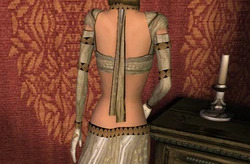
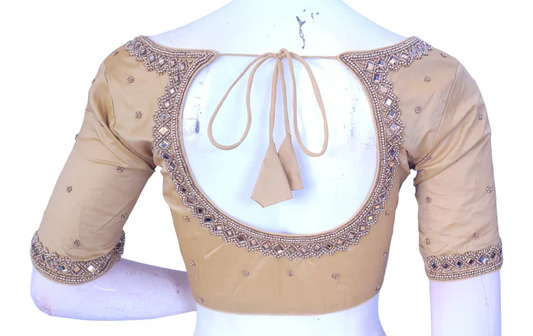
She's wearing something close to an Indian petticoat and blouse, but she's missing the saree. It might actually be what's around her neck. Indian blouses typically end above the stomach and are either long-sleeved (like what Eva's wearing) or go to the elbows. It even looks like the material might be the same, which would be silk. It seems to me that Eva Yan is doing in P1 what she's doing in P2; she's taking all of her favorite parts of a certain culture's dress and outfitting it to her tastes. Indian clothes are designed to be breathable, but Eva uses that design to look alluring. I would say that the Stamatins do the same thing in their own way; The Broken Heart's interior design and opium pipes evoke the Western-exported idea of Asian drug dens and they name their dead colleague Farkhad, based off the Persian story of Khosrow and Shirin, whether he was Persian, in the area or not - we wouldn't know.
Maria(and Eva?)'s occasional use of the honorific en-Daniil is reflective of this, too. "en" is short for "encik" and is a Malaysian convention. The reason why it's "en-Daniil" and not "en-Dankovsky" is because Malaysian names are structured like "Razak bin Osman," where the "bin" means "son of." It would be odd to call someone "Mister son of Osman," so it's either "en-Razak" or "en-Razak bin Osman."
Off the top of my head, those are the most explicit examples ... and, obviously, the Utopians all use the Kin's culture and aesthetics, too, and incorporate whatever about it interests them into their lifestyles. That aside (or not), as for why the Utopians specifically do this --- it may really be because they live in Asia. Personally, I interpret this as a very individualistic case of orientalism that expresses how Utopians seek out aesthetic beauty and concepts they find both appealing and "other" --- whether this is natural-law-breaking ideas or other cultures. I think this is a very cherry-picked kind of admiration.
#pathologic#eva yan#maria kaina#andrey stamatin#peter stamatin#not to say that its “good” or “bad” just that they do it yk#if anyone else has other examples...#man-of-letters
78 notes
·
View notes
Text


Iranian-backed Houthi terrorists fired two anti-ship ballistic missiles at a Greek-flagged ship headed to Yemen to deliver grain on Monday, causing minor damage, according to U.S. Central Command.
Despite the minor damage on the U.S.-owned M/V Sea Champion, the ship continued on course to Aden in Yemen, where it ultimately delivered the grain for the benefit of the Yemeni people.
Central Command said the M/V Sea Champion has delivered humanitarian aid to the country 11 times over the past five years.
"Houthi aggression in the region has exacerbated already high levels of need in conflict-impacted Yemen, which remains one of the largest humanitarian crises in the world, with nearly 80 percent of the entire population needing humanitarian assistance," Central Command said. "We are committed to countering the Houthis’ malign activities, which directly endanger the imports of foodstuff and humanitarian aid to Yemen."
Another ship in the Gulf of Aden, the British-registered, Lebanese-operated Rubymar, sustained damage on Sunday after "an explosion in close proximity to the vessel."
The explosion was reportedly caused by two missiles fired at the ship by Houthi rebels and resulted in the ship taking on water.
The crew was able to evacuate the vessel safely.
Houthi Brig. Gen. Yahya Saree later issued a statement claiming the rebel group’s responsibility for the attack, saying the vessel was "now at risk of potentially sinking."
"The ship suffered catastrophic damages and came to a complete halt," Saree said.
The Houthis also claimed to have downed an American drone Monday in the Yemeni port city of Hodeidah, according to Reuters. U.S. Central Command, which operates in the region, did not immediately respond to a request for comment from Fox News Digital.
The Houthis last November took out a U.S. MQ-9 Reaper drone near the Yemeni coast.
The reported attacks come after the U.S. launched five "self-defense" airstrikes against a series of Houthi rebel positions in Yemen on Saturday.
The strikes targeted three anti-ship missile batteries, one unmanned underwater vessel (UUV) and another unmanned surface vessel (USV), U.S. Central Command (CENTCOM) announced Sunday.
"This is the first observed Houthi employment of a UUV since attacks began on Oct. 23," CENTCOM said in a statement.
159 notes
·
View notes
Text
Memo for Episode 6 “The Crystal Pavilion, for the Third Time”
猫猫(緑(みどり)がかった目……玉葉様(ギョクヨウさま)と同(おな)じ西方(さいほう)の生(う)まれか?昨日は肝(きも)っ玉(たま)母(かあ)ちゃんに見えたけど、落(お)ち着(つ)いて話すと聡明(そうめい)な印象(いんしょう)だな…。何(なん)にせよ、お茶(ちゃ)まで出されて気(き)が引(ひ)ける…)
Maomao (Midori-gakatta me……Gyokuyo-sama-to onaji saiho-no umare-ka? Kinowa kimottama-kaachan’ni mieta-kedo, ochi-tsuite hanasu-to someina insho-dana… Nan’ni-seyo, ocha-made dasarete kiga hikeru…)
Maomao (Green-tinted eyes… Is she from the western region, like Lady Gyokuyou? She seemed like a ‘tough mother hen’ type yesterday, but in a calm setting, she gives a wise, reserved impression. At any rate, this is intimidating, with the nice tea and everything.)
〇〇がかる(〇〇gakaru): becoming like 〇〇 ex) 神がかった(かみがかった/Kami-gakatta): Godlike, divine
〇〇(Color)+がかる = colored like 〇〇 (not completely but close)
肝っ玉母ちゃん(きもったまかあちゃん/Kimottama-kaachan): I don’t know “tough mother hen” but I can imagine. It means a tough, powerful, gutsy mother.
深緑「昨日は失礼(しつれい)いたしました。貴妃(きひ)のところの方(かた)とはつゆ知(し)らず」
Shenryu “Kinowa shitsurei itashi-mashita. Kihi-no tokoro-no kata-towa tsuyu-shirazu.”
Shenlü “Please excuse me for my attitude yesterday. I had no idea you worked for the Precious Consort.”
つゆ知らず(つゆしらず/Tsuyu-shirazu): not knowing at all
露(つゆ/Tsuyu): dew + 知らず(shirazu) = つゆほども知らない(Tsuyu-hodo’mo shira-nai): not knowing even a bit
――――――――――――――――――――――――――――――
桜花「それがどういうことか分(わ)かってるの!?医官以外が薬を作っていると、もし表沙汰(おもてざた)になったら…!」
Infa “Sorega do-iu kotoka wakatteru-no!? Ikan-igaiga kusuri’o tsukutte-iruto, moshi omote-zatani nattara…!”
Yinghua “Do you understand what you’re saying?! If people find out that someone who’s not a doctor is making medicines…!”
表沙汰になる(おもてざたになる/Omote-zata’ni naru): Something that you don’t want to be known to the public become public.
――――――――――――――――――――――――――――――
杏「どうしたも何(なに)もないわ。病(やまい)がうつらないよう、病人(びょうにん)を隔離(かくり)するのは常識(じょうしき)でしょう?」
Shin “Doshita-mo nanimo naiwa. Yamaiga utsura-nai-yo, byonin’o kakuri-suru-nowa joshiki-desho?”
Shin “Why not? Isn’t it common sense to quarantine a sick person to make sure the illness doesn’t spread?”
うつる(utsuru): contagious “うつる” is used as a verb.
Ex) 私の風邪が母にうつった(わたしのかぜが、ははにうつった/watashino kaze’ga haha’ni utsutta): My cold was passed on to my mother. / My mother got my cold.
――――――――――――――――――――――――――――――
壬氏「これはどういうことだろうか?杏殿(シンどの)。キャラバンの品(しな)には、毒物(どくぶつ)になり得(う)るものがあったため回収(かいしゅう)する。そう、触(ふ)れが出(で)ていたはずだが」
Jinshi “Korewa do-iu koto daroka? Shin-dono. Kyaraban’no shina’niwa, doku-butsu’ni nari-uru-mono’ga atta-tame kaishu-suru. So, fure’ga dete-ita-hazu-daga.”
Jinshi “What is the meaning of this, Lady Shin? Some items from the caravan were to be confiscated, as they could make poisons. That was the clear directive.”
触れ(ふれ/Fure): orders or instructions issued from government offices to common people (old word)
――――――――――――――――――――――――――――――
杏「それより、いきなりやって来て、梨花様に会わせろと言った挙(あ)げ句(く)、他(ほか)の宮の物置を漁(あさ)る方(ほう)が問題(もんだい)では?そもそも、病人に食事(しょくじ)を運(はこ)ぶくらいでしか、人(ひと)の寄(よ)り付(つ)かない場所(ばしょ)です。逆(ぎゃく)を言えば、誰(だれ)でも近(ちか)づけました。これらが私の物である証拠(しょうこ)でも?」
Shin “Sore-yori, ikinari yatte-kite, Rifa-sama’ni awasero-to itta ageku, hokano miya’no mono-oki’o asaru-hoga mondai’dewa? Somo-somo, byonin’ni shokuji’o hakobu-kuraide-shika, hito’no yori-tsukanai basho desu. Gyaku’o ieba, dare-demo chika-zuke-mashita. Korera-ga watashi’no mono’de-aru shoko’demo?”
Shin “On the other hand, for them to suddenly barge in here demanding to see Lady Lihua, only to then start ransacking our shed, is somehow not a problem? In fact, the only reason anyone went to that place was to feed the sick. Conversely, anyone could be there at any time. How can you prove that these items belonged to me?”
挙げ句(あげく/Ageku): (after doing a lot of things) finally, at last. This word is mainly used in a negative meaning.
――――――――――――――――――――――――――――――
杏「熱(ねつ)に浮(う)かされ、朦朧(もうろう)としていた下女の発言(はつげん)を?どこまで信頼(しんらい)できますか」
Shin “Netsu’ni uka-sare, moroto shite-ita gejo’no hatsu-gen’o? Doko-made shinrai deki-masuka.”
Shin “The testimony of a barely conscious, feverish servant? Is that trustworthy?”
朦朧とする(もうろうとする/Moro-to suru): barely conscious, half conscious, be in a hazy state
――――――――――――――――――――――――――――――
猫猫「大(たい)したことはありません。そうですね。私などが触れてよいわけがありませんでした。違(ちが)う方(かた)に調(しら)べてもらいましょう」
Maomao “Tai-shita-kotowa ari-masen. So-desune. Watashi-nadoga furete-yoi-wakega ari-masen-deshita. Chigau kata’ni shirabete-morai-masho.”
Maomao “It’s no big deal. You’re right. I had no right to lay my hands upon you. Let’s have someone else investigate.”
大したことはない(たいしたことはない/Taishita kotowa nai): It’s no big deal.
大したこと(たいしたこと/Taishita koto): big deal
Don’t read 大した(tai-shita) as だいした(dai-shita). It’s a big difference for Japanese and it could be mistaken for “having a bowel movement.”
小(しょう/Sho)、小さい方(ちいさいほう/Chiisai-ho): No.1, pee
大(だい/Dai)、大きい方(おおきいほう/Ookii-ho): No.2, poo
Of course, usually, 小 means “small” and 大 means “big/large”. But the combination with “する” could be easily misunderstood.
――――――――――――――――――――――――――――――
杏「くっ…。何、上(うえ)から目線(めせん)で言ってるの…。そういうところが昔(むかし)から嫌(きら)いなのよ!!勉強(べんきょう)も作法(さほう)も私の方(ほう)ができた!他にもいっぱい、あなたよりも私の方が優(すぐ)れてるのに!何で…周(まわ)りはみんな…!」
Shin “Ku… Nani, ue’kara-mesen’de itteru-no… So-iu-tokoro’ga mukashi’kara kirai-nanoyo! Benkyo’mo saho’mo watashi’no-hoga dekita! Hoka’nimo ippai, anata-yorimo watashi’no-hoga sugureteru-noni! Nande…mawari’wa minna…!”
Shin “What, now you’re talking down to me? That’s what I’ve always hated about you! I was always better at my studies and manners than you! And I excel in so many more things than you! And yet, why does everyone…!”
上から目線(うえからめせん/Ue-kara-mesen): talking down, looking down
This is a recent trendy phrase mainly among young people.
――――――――――――――――――――――――――――――
壬氏「それは自白(じはく)と捉(とら)えていいか?」
Jinshi “Sorewa jihaku’to toraete iika?”
Jinshi “May I consider that a confession?”
自白(じはく/Jihaku): confession
I like this line by Jinshi, at this timing. It’s very cool!
――――――――――――――――――――――――――――――
杏「はぁっ!ふ、触れるな!宦官ごときが汚(けが)らわしい!離(はな)せ!離せぇ!はっ」
Shin “Haa! Fu, Fureruna! Kangan-gotoki’ga kegarawashii! Hanase! Hanasee! Ha.”
Shin “Don’t tough me! Unhand me, you filthy eunuch! Let go!”
〇〇ごとき(〇〇Gotoki): This word itself means “like/such as” but it is added in order to insult 〇〇.
It’s also used when we want to humble ourselves.
Ex) そのような大役(たいやく)は私(わたし)ごときには務(つと)まりません(Sono-yona tai-yaku’wa watashi-gotoki-niwa tsutomari-masen): I can’t take on such a big role. ←Such important role cannot be fulfilled by someone like me.
――――――――――――――――――――――――――――――
猫猫「フフッ」(やるなぁ。もう昔の梨花様じゃない。自分(じぶん)の玉(たま)の緒(お)のついえるのを待つ儚(はかな)げな女性(じょせい)は、どこにもいない)
Maomao “Fufu.” (Yaru-naa. Mo mukashi’no Rifa-samaja nai. Jibun’no tama’no o’no tsuieruno’o matsu hakanagena josei’wa, doko-nimo inai.)
Maomao (Well played. She’s no longer how she was in the past. She’s no longer the fading, frail woman, waiting for her life’s thread to sever itself.)
やるなぁ: “Well played” is perfect here. Please say it with a long ending, “なぁ、なー”softly. Otherwise “やるな” can mean “Don’t do it.”
――――――――――――――――――――――――――――――
梨花妃「今後一切(こんごいっさい)、後宮(こうきゅう)への立(た)ち入(い)りを禁(きん)じてください」
Rifa-hi “Kongo-issai, kokyu’eno tachi-iri’o kinjite-kudasai.”
Concubine Lihua “Please ban her from ever entering the rear palace again.”
今後一切(こんごいっさい/Kongo-issai): Never again
――――――――――――――――――――――――――――――
This was an impressive episode, with Shin’s villainy and Concubine Lihua’s resolute behavior. Normally, Shin would have been sentenced to death, but Concubine Lihua deliberately behaved in this way to avoid that. Sadly, Shin will never understand this. If Shin had not been Concubine Lihua’s head lady-in-waiting, Concubine Lihua would not have lost the prince, and as the mother of the next emperor, she might have been in a more advantageous position than Concubine Gyokuyou. Anyway, I’m glad that the Crystal Pavilion is finally going to be run properly.
#apothecary english#apothecary romaji#the apothecary diaries#apothecary diaries#learning japanese#japanese#薬屋のひとりごと#薬屋のひとりごと 英語#薬屋 英語 学習#japan#KNH#season 2
21 notes
·
View notes
Note
I understand if this is outside your field of expertise, but do you think if the ornamentation of the clothing that (some of) the kobolds drawn by Kui wear is inspired by anything?
Actually this is exactly my field of expertise! I studied costume design for about two years in university before switching to something else :) So clothing is something I love looking at and talking about, and fashion history is one of my favorite elements of history in general!
HOWEVER, though I have some experience with subject, I'm not a fully trained expert in the field, and I know that I may not have all the answers, so please take what I say with a grain of salt. This is only my educated guess.
I'm assuming that you're talking about this page from the Daydream Hour book:
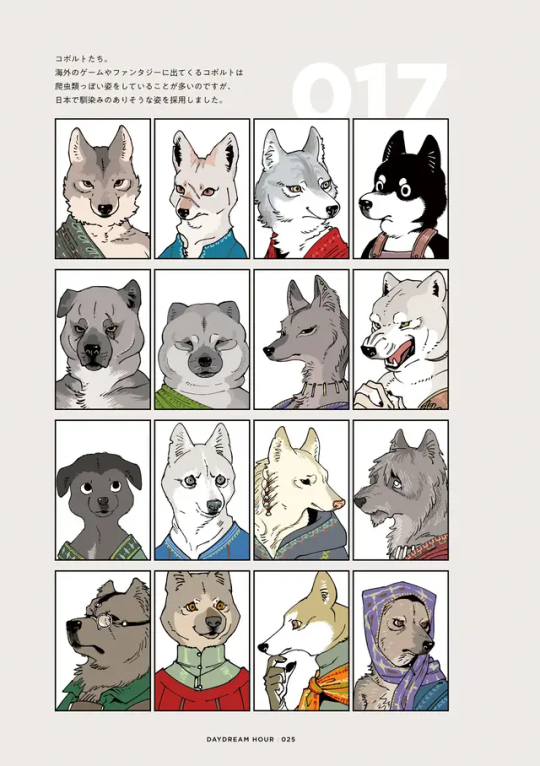
To start with, the caption says: "Kobolds that appear in foreign games and fantasy often have a reptilian appearance, but we chose an appearance that is more familiar in Japan." This doesn't tell us anything about their clothing, but I wanted to translate it to make sure it didn't say anything about their culture.
(You can read more about why the Dungeon Meshi kobolds are dogs in the Half-foot chapter of my Dungeon Meshi research project)
Kobolds likely live all over the world, but their large population centers are all located in the Western Continent, so that is probably the region they consider home.
So those two kobolds on the bottom left of the chart, who appear to be wearing European-inspired clothing, are probably living somewhere in the Eastern hemisphere, where Northern/Western/Central/Eastern European clothing is the norm, while the rest are likely from the West. So we can discard the European-looking clothes, since that's probably not a part of the kobold's traditional culture.
We have very limited information about the Western Continent, but these images plus what we know about Kabru (His name and Utaya's name are both South Asian, the dessert that comes from Utaya is South Asian) and the elves (several of them have South Asian names, some elves wear South Asian clothing and bindis) makes me think there's probably a strong Indian/South Asian influence in the Western Continent. It's a large land mass, so I don't think it's all South Asian, but South Asian culture is the only thing we have conclusive evidence of so far.
The majority of the kobolds are wearing brightly colored tunics with patterns on the hems, or what seems to be dresses/tunics made of draped fabric, also with hem decoration.
It IS worth noting that Kui avoids drawing elaborate patterns, even when it would make sense for her to do so. She does it only a couple of times in the manga and uses screentones instead whenever possible. So the simple hem decoration and single color fabric may just be an artistic choice that doesn't mean anything other than "I didn't want to draw a pattern." However, it's all we have to work with, so I'm going to assume it's intentional.
The repeated over-the-shoulder draped fabric the kobolds are wearing seems like it could only be a Greco-Roman style toga, palla, or cloak, or a South Asian saree. We have seen Western elves wearing garments similar to all of these on occasion, though obviously Kui has made some changes. As I say in my essay, I don't think any of the cultures in Dungeon Meshi is an exact copy of a real-world culture, Kui is remixing things together.
(Except for the Island of Wa, which seems to be entirely based on Sengoku-era Japan.)
Roman togas were just large pieces of cloth that they draped around their bodies, and they were usually white, with brown or black reserved for the lower-classes or for use during mourning, and purple or red reserved for extremely important people. Embroidery and trim, if they had it, was usually either very simple (plain colored stripes) or very elaborate (images of people, animals, or things).
So I think that rules out the toga as a possibility.
On the other hand, the saree and dupatta are also large pieces of cloth draped either around the body and over the shoulder (and sometimes the head), and usually they are either a single plain color, a plain color with a decorative trim, or an all-over pattern. This is a lot closer to what Kui draws the kobolds wearing.
(Pictures and more text after the cut)
Toga:


Saree:


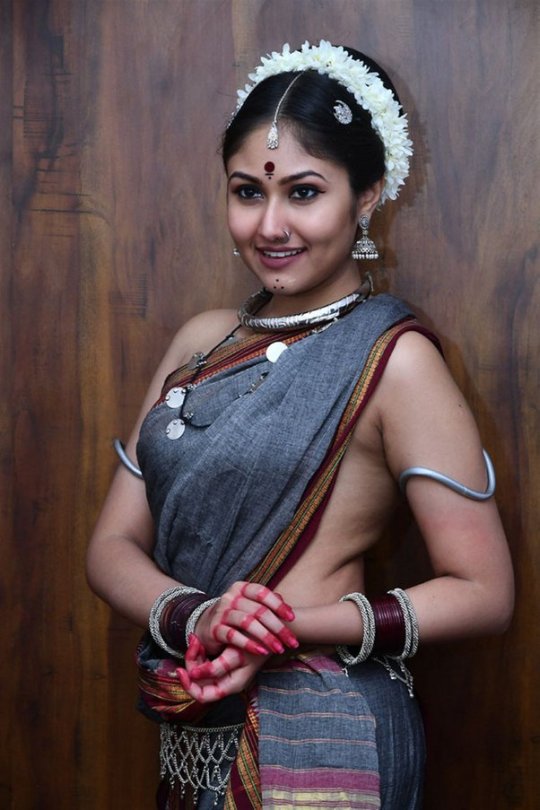






The tunics the kobolds are wearing could be many things, as what's visible is not an uncommon neck shape. They could be something like a kurta, kaftan, or abaya (tunic/robe)... And there's probably a dozen other similar garments that I'm neglecting to name.
There are a million variations on the kurta, but these neck styles looks like what Kui is drawing on a couple of those kobolds.



However, some of the tunics COULD also just be a depiction of what is often called a "Viking tunic" or kyrtill (Nordic name for a kirtle or tunic).

However in Dungeon Meshi, the kyrtill is extensively worn in the Eastern hemisphere, primarily by dwarves, tall-men and half-foots. So I don't think the Western hemisphere kobolds are wearing them, and the style of trim looks different to me than what Kui drew.
Kobold fashion could also be influenced by any culture from North Africa, West Asia, or the Middle East, as these are also cultures that appear to dominate the Western hemisphere of Dungeon Meshi, and that have similar fashion cultures involving patterned textiles and draping cloth/veils/head coverings...
However, because of what seems like a large draping cloth over the shoulder, and the combination of trim with a solid color, I think the primary influence is South Asian rather than these other cultures.
I hope that helps! And keep in mind that Kui loves to remix things, so I'm sure there's elements from other cultures that would fit right in with what she's shown us of the kobolds, if you want to get creative with your fan works!
#dungeon meshi#delicious in dungeon#dunmeshi#kuro dungeon meshi#kobolds#analysis#talking mushroom#The Essay
56 notes
·
View notes
Note
as a south asian why the hell did they make aladdin and jasmine south asian. I am so confused. Isn't jasmine's name literally persian
Okay okay so there's a bit of a story for this
And to quickly answer your last question, yup, Jasmine is one of the forms of Yas/Yasmine, our jasmine flowers
So back in the 90s, and still a little bit today, many production companies such as Disney didn't really see a difference with the Middle East and South Asia. When Disney decided they wanted to make an adaptation of "Aladdin" from "One Thousand and One Nights" (slight tidbit here, the story of Aladdin is not part of the original book. A French guy added it in and for some reason, set it in China? One Thousand is a Persian story, most of the stories in there are Persian, so this choice was. Interesting), it's not like they suddenly hired a bunch of Middle Eastern experts to consult on the film. No, they just created a desert-y landscape and lumped in Persian, Arab, and South Asian all in there
This is why the palace of Agrabah heavily resembles the Taj Mahal on a more Arabic-sounding name. Rajah, Jasmine's pet tiger, is an Indian word for king. Names such as Jafar and Jasmine are Persian in origin, while a lot of the clothing is Turkish-inspired. Villains such as the Captain and Jafar have a lot more stereotypically Middle Eastern features (hooked nose, bushy eyebrows, etc [and it's a convo for another day about how the "good" characters don't have these exaggerated features])
This melding of several cultures is what led up to the live-action "Aladdin" in 2019. The creators of that movie wanted to be more respectful of the region, and so this time, they did hire consultants and the like to help ensure it would be much less offensive ("where they cut off your ear if they don't like your face", nice going 1992)
And for the most part, they did that. Except for Jasmine
Jasmine is played by Naomi Scott, a half white half Indian woman, and look, it's pretty obvious she only got this part because she's well known. I would also like to point out that the casting calls for the characters in general once again lumped Southeast Asian and Middle Eastern people, however, almost all of the cast is Middle Eastern, and several of them are Persian (Sultan and Mara, notably)
So while everyone else is wearing clothes more indicative of the Middle East, you have miss Jasmine over here dressed in sarees and Indian-inspired clothing because costuming department went "oh! She's Indian now!" Agrabah is also a lot more similar to South Asia than the Middle East, further deepening this issue
To an outsider, "Aladdin" is Indian. To them, there's some Arab inspo, but they would mostly think it's set somewhere in India or South Asia. That's what the casting and costuming department in "Rise of Red" were working with, and so they just opted to go the whole South Asian angle. None of the actors who portray Jasmine, Aladdin, and their kid are Middle Eastern, they're all South Asian. The clothes they're wearing are very obviously from that region
And if I'm being completely honest, that's exactly what I expect from Disney. Why would they bother to do research for extremely minor characters with two lines? The problem here is what I've been talking about above, is that Hollywood is constantly thinking South Asians and Middle Easterners are interchangeable when we're not. If I see a MENA character on screen, more often than not the actor is South Asian. This is a continuous problem no one from these places wants to see happening, and yet it is because Hollywood doesn't actually care. The more it's done, the more they think it's okay and so they continue to blur the lines between several different cultures
So, on an ending note, Jasmine and Aladdin are Arab, if not Persian, and the idea that we are interchangable with South Asians harms both our cultures
#jasmine#aladdin#disney#descendants 4#descendants#naomi scott#mena massoud#aladdin 2019#rise of red#descendants rise of red
30 notes
·
View notes
Text
World Women in Sarees: Explore the Diversity of Indian Saree Drapes"

"Hey, lovelies! Welcome back to my blog, where we celebrate the beauty and diversity of sarees from around the world!
Today, I want to showcase the stunning Nivi drape, a classic style from South India. This gorgeous red saree is adorned with intricate gold embroidery, adding a touch of luxury to the overall look.
But what I love most about sarees is the countless ways you can drape them! From the elegant Pallu drape to the trendy Seedha Pallu style, each region in India has its own unique way of wearing a saree.
Stay tuned for more saree inspiration, and don't forget to share your own favorite saree styles with me!
#womens fashion#SareeLove#IndianFashion#SareeInspiration#WomenInSarees#DiversityInFashion#indian girl#desi women#desi wife#indian beauty
11 notes
·
View notes
Text
The Houthi movement in Yemen has claimed responsibility for three attacks on the USS Harry S. Truman aircraft carrier in the Red Sea over the past 24 hours. The group's military spokesman, Yahya Saree, stated that these operations involved the use of cruise missiles and drones, targeting the American naval vessel as well as other enemy ships. The Houthis also reported facing seven US airstrikes in the Saada region of Yemen.
In a separate incident, the Israeli military reported intercepting a ballistic missile launched from Yemen before it entered Israeli airspace. Air raid sirens were activated across central Israel, including areas near Jerusalem and parts of the West Bank, in response to the missile launch. Missile fragments were reported to have fallen in the Jerusalem area, and a Ryanair plane was forced to turn back due to the incident.
Additionally, the Houthis announced a successful attack on Israel's Ben Gurion Airport in Tel Aviv with a Zulfiqar ballistic missile. The operation was claimed to be in support of the Palestinian people and a response to American aggression, with the Houthi military spokesman asserting that the missile hit its target accurately. The Houthis stated that their actions are in solidarity with Gaza.
2 notes
·
View notes
Text
Bridal Beauty Across India – See How Styles Change by Region!

So, if you’re planning a wedding or simply love exploring different bridal styles, get ready to be amazed. Let’s take a journey through India’s most stunning bridal looks. Which one is your favorite?
1. North Indian Brides — Royal, Bold, and Stunning
If you love grandeur and drama, you’ll fall in love with North Indian bridal fashion. Brides from Punjab, Haryana, Uttar Pradesh, and Delhi go all out with luxurious red or maroon lehengas, heavy embroidery, and extravagant jewelry.

Would you love to wear this majestic North Indian bridal look on your big day?
2. Bengali & Odia Brides — The Perfect Blend of Elegance & Tradition
Eastern India is known for its dramatic yet elegant bridal fashion. If you love classic sarees and bold makeup, this look will steal your heart.

Can you see yourself as a bold and beautiful Bengali bride?
3. Rajasthani & Gujarati Brides — A Touch of Royalty & Culture
Do you dream of looking like a queen on your wedding day? Then you’ll love the stunning bridal looks from Rajasthan and Gujarat.

If you had to pick, would you go for the royal Rajasthani elegance or the vibrant Gujarati charm?
4. South Indian Brides — Timeless, Graceful, and Stunning
If you adore silk sarees, temple jewelry, and a regal aura, the South Indian bridal look is for you.

Are you a fan of the South Indian bride’s timeless elegance?
5. Maharashtrian Brides — Graceful & Unique
Want to stand out from the crowd? The Maharashtrian bride has a distinct and graceful look.

Fresh mogra flowers in her bun complete the look. It’s a blend of elegance, tradition, and sophistication. Would you love to wear this unique bridal style?
6. Northeastern Brides — Minimalistic Yet Gorgeous
Bridal fashion in Northeast India is different yet incredibly beautiful. If you love lightweight, handwoven fabrics and subtle beauty, these styles are for you.

Which Northeast bridal look would you love to try?
7. Central Indian Brides — A Fusion of Styles

Would you go for a fusion bridal look, combining the best of both worlds?
Which Indian Bridal Look Is Your Favorite?
The Indian Bridal Look is as diverse as the country itself. Whether you love the grandeur of a North Indian bride, the simplicity of a Kerala bride, or the royal elegance of a Rajasthani bride, each style tells a story of tradition, culture, and timeless beauty.
So tell us — which bridal look captures your heart? Would you mix and match styles or stick to your traditional roots? Let’s celebrate the stunning diversity of Indian brides.
#Indian Bridal Look#traditional indian bride#wedding bridal look#reception bridal look#indian bridal saree look#simple bridal look#indian bride#indian bridal dress#bridal look in lehenga
2 notes
·
View notes
Note
Lol at the anon with the sweater/sweatshirt and Washington/Virginia ask
Yeah, sure, lemme go and study in meticulous detail every minor regionalism and geographical feature of your Greatest Nation so I can write fics for fun more correctly. While the rest of us can’t expect an USAmerican to find our country on a map, let alone its capital, or to know that not every single garment in Asia is either a kimono or a saree. I get pet peeves and neurodivergence but come on.
--
46 notes
·
View notes
Text
Ajrakh Print Fabric: A Timeless Tradition of Hand Block Printing

Ajrakh print fabric is an ancient textile art form that has been cherished for centuries. Originating from the regions of Sindh (Pakistan) and Kutch (India), Ajrakh is a unique hand-block printing technique that embodies rich cultural heritage, intricate designs, and a meticulous dyeing process. This fabric is revered for its deep, earthy colors and symmetrical patterns, making it a timeless masterpiece in the world of textiles.
History and Origins
The history of Ajrakh dates back over 4,000 years, with evidence of similar block-printed textiles found in the ruins of the Indus Valley Civilization. The craft flourished under the patronage of the Mughal Empire and later found its stronghold in the Kutch region of Gujarat, where communities like the Khatris have preserved the tradition for generations.
Ajrakh printing was traditionally associated with the Sindhi and Kutchi communities, particularly the pastoral Maldharis, who used it as a part of their daily attire. The word 'Ajrakh' is believed to be derived from the Arabic term 'Azrak,' meaning 'blue,' signifying the dominance of indigo hues in the fabric.
The Intricate Process of Ajrakh Printing
Ajrakh printing is a labor-intensive process that involves multiple stages, each requiring immense skill and patience. The traditional method consists of the following steps:
Pre-Treatment of Fabric: The fabric (usually cotton or silk) is first washed and treated with natural substances like camel dung, soda ash, and castor oil to remove impurities and enhance dye absorption.
Block Printing: Skilled artisans carve intricate patterns onto wooden blocks, which are then used to print designs onto the fabric using resist techniques.
Natural Dyeing: Ajrakh is known for its use of organic dyes, including indigo, madder, turmeric, and pomegranate peels. The dyeing process is repeated multiple times to achieve the rich, deep colors.
Sun-Drying and Washing: The fabric is sun-dried between each dyeing phase and undergoes multiple washes to ensure color fastness.
Final Finishing: The finished fabric is given a final rinse and dried, revealing the vibrant, symmetrical patterns characteristic of Ajrakh.
Unique Characteristics of Ajrakh Fabric
Ajrakh fabric stands out due to its:
Geometric and Floral Motifs: The designs are symmetrical and often inspired by nature, stars, and Islamic architecture.
Reversible Printing: Many Ajrakh fabrics have the same design on both sides, showcasing the precision of hand-block printing.
Sustainable and Eco-Friendly Production: The use of natural dyes and traditional methods makes Ajrakh an environmentally friendly textile art.
Modern Adaptations and Uses
While traditionally used for turbans and shawls, Ajrakh fabric has evolved with time and is now widely used in modern fashion. Designers incorporate Ajrakh prints into sarees, dresses, jackets, scarves, and even home decor items like cushion covers and table linens.
Preserving the Legacy of Ajrakh
Despite industrial advancements, artisans in Kutch and Sindh continue to uphold the authenticity of Ajrakh printing. Many organizations and designers are working to promote and sustain this craft by creating contemporary designs while maintaining traditional techniques.
Conclusion
Ajrakh print fabric is not just a textile; it is a story woven into fabric, reflecting the history, art, and craftsmanship of generations. With its unique blend of tradition and modern appeal, Ajrakh remains a cherished and valuable part of India’s and Pakistan’s cultural heritage. Whether in fashion or home decor, the elegance of Ajrakh continues to captivate art and textile lovers worldwide.
2 notes
·
View notes
Text
Why Punjabi Juttis Are the Ultimate Valentine’s Day Footwear Choice
Valentine's Day is about love, romance, and sharing time with those special people in your life. While everyone tends to worry about their clothes, the right shoes can make all the difference in how you look and feel. If you want to dress up your Valentine's Day look, nothing beats the classic elegance of a pair of Punjabi juttis. These heritage shoes, famous for their distinctive style and cultural heritage, provide comfort and glamour, making them the ideal shoe for this occasion.

In this article, we will discover why Punjabi juttis are the go-to Valentine's Day footwear option, how you can pair them with any kind of clothing, and why they should be on your shopping list. If you're having a romantic dinner or an everyday date, Punjabi juttis will be that ideal combination of classiness and tradition that completes your outfit.
What Are Punjabi Juttis?
Punjabi juttis are a classic style of shoe that hail from the Punjab region, which stretches across India and Pakistan. Punjabi juttis are reputed for having elaborate hand-embroidered patterns, bright colors, and a characteristic flat design. The juttis themselves are crafted out of leather, cloth, or velvet and come with intricate stitching, mirror work, and beading, and these are notable both as a functional as well as fashionable choice of shoe.
What distinguishes Punjabi juttis from other footwear is the fact that they have no heel and, thus are easy to wear for extended periods. They provide a close fit and are usually available in different colors, designs, and adornments, thus a stylish twist that makes them not only appropriate for casual activities but also for more formal events. These juttis have, over time, adapted to new tastes while maintaining their classic appeal, thus becoming a favorite among people during festive events such as weddings, cultural festivals, and, of course, Valentine's Day.
Why Choose Punjabi Juttis for Valentine’s Day?
Valentine's Day is a day when everyone wishes to feel special, and the right footwear is an important part of that. Here's why Punjabi juttis are the ideal option to top off your Valentine's Day look.
1. A Perfect Blend of Tradition and Modernity
Punjabi juttis elegantly marries traditional skills with modern design inputs. Whether you're dressed in a saree, a salwar kameez, or even a Western garment, these juttis bring with them a distinct cultural flavor that can change your style. Their timelessness renders them versatile enough to go along with trendy fashion without losing their roots. If you are dressing up with a bold, eye-catching look on Valentine's Day, a pair of bright, intricately worked juttis is sure to stand out.
2. Comfortable All-Day Wear
Unlike high heels, which hurt to wear all day, Punjabi juttis are the perfect comfort choice. Their plush leather make and flat bottom design mean you'll be comfortable morning till night, so whether dancing the night away at a Valentine's Day function or taking an evening stroll to dinner, you can keep on your juttis all day without a moment's discomfort. You don't have to compromise style for comfort, and that is exactly what you get from Punjabi juttis - pure comfort mixed with pure style.
3. A Wide Variety of Designs
Punjabi juttis have an array of designs, so that you can select the most suitable one that suits your style as well as Valentine's Day dress. Right from traditional metallic colors to vibrant and bold colors, there is something for every moment. If you want to go for a sophisticated look with a subtle touch, a plain designer Punjabi jutti can provide sophistication as well as elegance. Want to stand out? Go for the juttis with elaborate beadwork, sequins, or embroidery providing a spark of glamour to your entire look.
4. Versatility for Any Outfit
One of the main reasons Punjabi juttis are perfect for Valentine's Day is its versatility. The juttis can complement traditional Indian outfits like lehengas, anarkalis, or sarees as well as dresses or skirts or pants. For an evening intimate setting, they can be paired with a flowing gown or a classically designed blouse with jeans - a stylish, yet traditional take. Whether you want boho or just an elegant affair, Punjabi juttis are versatile enough to be styled according to your fashion choices.
5. A Unique Gift Idea
If you are not planning to buy them for yourself, then gift a pair of Punjabi juttis to your loved one on Valentine's Day. Their intricate designs and handcrafted nature make them a thoughtful and meaningful gift. A pair of well-chosen juttis is not just a piece of footwear but a statement of love and appreciation. Plus, the uniqueness and cultural significance of the juttis will remind them of the special day whenever they wear them. Read the article to know more about choosing the best punjabi juttis.
6. Perfect for Every Valentine’s Day Setting
Valentine's Day is very different regarding the way people may celebrate it. Be it a quiet dinner for two, or a romantic dance, or simply a casual outing, Punjabi juttis would suit any ambiance. The beauty of the design suits them to formal situations, while comfort and ease with design make them good for casual outings as well. This makes it all-in-one footwear for every celebration.
7. Sustainable and Ethically Made
Many modern designers who create Punjabi juttis focus on sustainable and ethical production methods. Sustainable fashion is getting more attention lately, and with that, such shoes are created using eco-friendly materials like vegan leather or fabric sourced locally. When you purchase a pair of juttis, you're not just supporting traditional craftsmanship but also contributing to the preservation of culture and the environment. Choosing ethical and handmade products gives your Valentine's Day a little extra meaning, knowing that your footwear is supporting a cause you can feel good about.
How to Style Punjabi Juttis for Valentine’s Day
Styling your Punjabi juttis for Valentine’s Day is all about balancing comfort and glamour. Here are some tips to help you put together the perfect look:
Pair with a Long Dress or Gown: For an elegant and flowing look, match your Punjabi juttis with a maxi dress or gown. The intricate patterns and bright colors of the juttis will complement the flow of the fabric and create a stunning visual effect.
Traditional Outfits: If you're wearing a saree or lehenga, Punjabi juttis are the perfect complement. The rich embroidery and designs can add a fresh and modern touch to traditional attire.
With Casual Wear: Punjabi juttis also work well with casual outfits like a long tunic, kurti, or even a pair of jeans. Keep the look relaxed yet fashionable with simple designs, and add accessories like a statement necklace or earrings to complete the outfit.
For Date Night: If you're keeping it simple yet elegant, pair a Punjabi jutti for women with a sleek outfit like a chic jumpsuit, tailored pants, or a little black dress. A metallic or embellished pair will add the right amount of glam to your ensemble.
Why You Should Choose Mystic Sole for Your Punjabi Juttis
The right brand is what matters in finding the ideal pair of Punjabi juttis for Valentine's Day. Mystic Sole offers a large variety of handcrafted juttis that marry traditional craftsmanship with contemporary styles. Whether you need a simple designer Punjabi jutti that matches a minimalistic outfit or something more elaborate for a bolder look, Mystic Sole has something to suit every taste.
Mystic Sole ensures to pay all attention to detail, great material, and comfort. Every single pair of juttis has been designed very carefully to have the perfect fit and long-term wear so you can feel sure and stylish the whole day through. Moreover, through online shopping, you could even Buy Punjabi Jutti Online from your home, sitting on your comfortable couch, using quick delivery systems so that they can reach in time for the day of Valentine.
At Mystic Sole, customer satisfaction is of great importance, and they are dedicated to helping you find the best footwear according to your needs. Whether you shop for yourself or a loved one, Mystic Sole is sure to guarantee that you get the perfect juttis in terms of aesthetics and comfort.
Conclusion
The ultimate Valentine's Day shoe would be Punjabi juttis, as they combine tradition, comfort, and style. These are very versatile, unique designs with timeless appeal, which makes them match any kind of outfit for an even more special Valentine's Day celebration. If you're going to create a statement or just stick to casual all-day comfort, Punjabi juttis are a perfect fit. So, why not buy yourself or someone you love such a beautiful iconic pair of shoes this Valentine's Day?
When you finally decide to seek the perfect fit, look for no other store than Mystic Sole, where quality meets traditions in every step.
#Buy Punjabi Jutti Online#Simple Designer Punjabi Jutti#Punjabi Jutti For Women#Valentine’s Day Footwear Choice#Valentine's Day#Punjabi juttis#mysticsole#gift for her#choosing the best punjabi juttis
2 notes
·
View notes